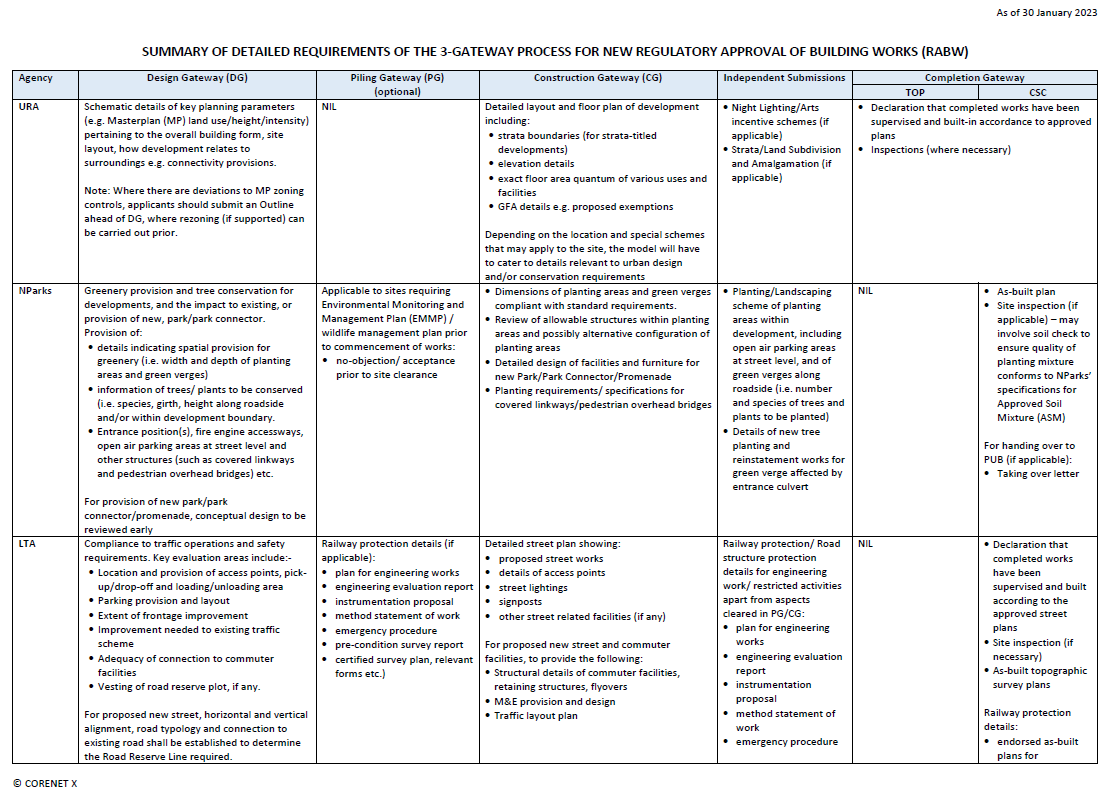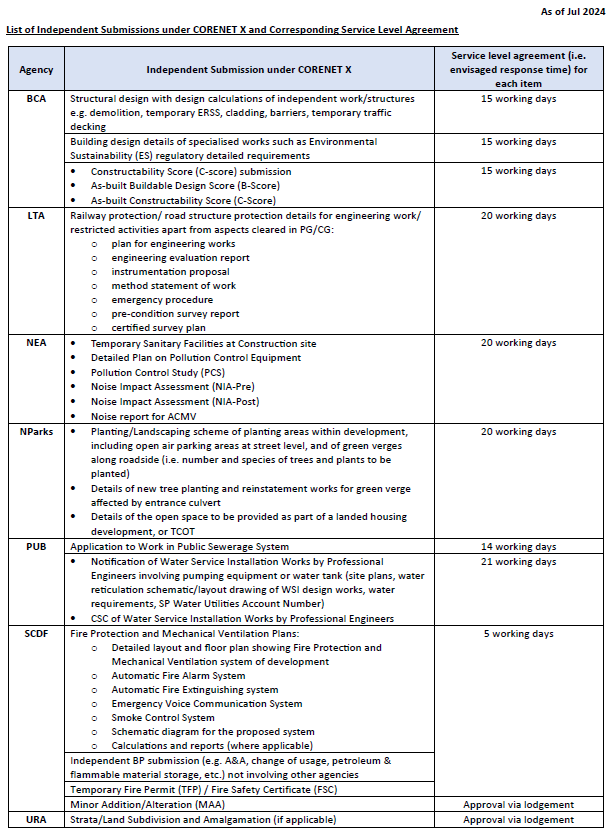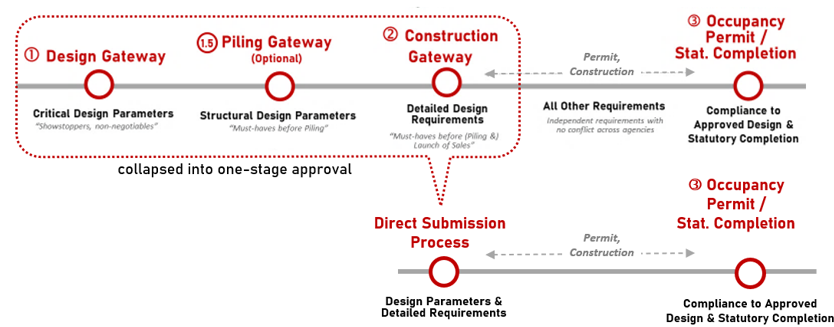Current Regulatory Approval Process
Building developments in Singapore are regulated by 8 key regulatory agencies: BCA, URA, LTA, NEA, NParks, PUB, SCDF and SLA for land and strata matters.
Under today's regulatory approval process, building projects typically have to go through more than 20 approval touchpoints and the project team will receive responses separately from regulatory agencies.
New Regulatory Approval for Building Works (RABW)

The new Regulatory Approval process for Building Works (RABW) streamlines the multiple touchpoints into 3 key sequential submission gateways. This new process aims to promote upstream design coordination and minimise downstream issues.
These “3-Gateways” will be the default submission process for all building projects, except for building projects that will undergo the Direct Submission Process (DSP). More information on the DSP can be found below.
At each Gateway, coordinated BIM submissions, consisting of various building disciplines, will be submitted and reviewed collectively by agencies. This approach aims to ensure cross-agency issues and conflicts are identified and resolved upfront.
The new process undergoes refinements from time to time based on industry feedback and observations from pilot projects. Since the inception of CORENET X, agencies have conducted various reviews to address potential impact and concerns. Visit the
Refinement to CORENET X Process page to find out more.
More information on the 3-Gateway Process
| Submission Stage |
Objective |
| Design Gateway |
To resolve key parameters (e.g. Master Plan land use, intensity, building massing, site layout, etc.) that have an impact on design parameters and client’s brief, before proceeding to detailed design
Note: For a typical project, submission at this stage would be made by the QP (Architect). He/She will coordinate with the other QPs to incorporate crucial details into the submission (e.g. location of the electrical sub-station, connection to the main sewerage and drainage points). |
Piling Gateway
(Optional) |
To resolve requirements pertaining to foundation works that do not affect the main structural works. This gateway is an optional gateway for piling works to allow work to start on the substructure while the rest of the details for the project are being worked out.
|
| Construction Gateway |
To resolve multi-agency requirements concerning detailed building design (e.g. layout, accessible route, fire escape route, etc.) that need to be coordinated before commencement of works and launch of sales. Project teams are only allowed to commence works after obtaining the necessary Gateway clearances and permits.
Note: For a typical project, submission at this stage will be a joint submission by the QP (Architect), QP (C&S Engineer) and QP (M&E Engineer), to clear the detailed design with regulatory agencies.
|
Independent submissions
(if applicable)
|
To clear agency-specific requirements of specific technical details or components that are regulated by a specific agency. These requirements can be submitted independently to the specific agency via the same CORENET X submission portal.
(e.g. Structural submission of ancillary structures and components such as barriers/ claddings to BCA) |
| Completion Gateway
|
To submit “As-Built” model and submit application for Temporary Occupancy Permit / Certificate of Statutory Completion
|
 |
Summary of Detailed Requirements at Each Gateway
|
 |
QPs working on a Coordinated Submission
- QPs only need to make submissions if there are requirements at the respective Gateways related to their statutory responsibilities.
- For Gateway(s) that a QP does not have to make submissions (e.g. Structural / M&E Engineers in the Design Gateway), these QPs will provide inputs to the Registered Architect so that the submission encompasses all aspects of planning.
- Between the Construction and Completion Gateways, the individual professionals can submit the agency-specific technical details as independent submissions to the respective agencies via the same CORENET X submission portal.
Independent Submissions
Independent submissions, or agency-specific submissions, can be submitted in parallel with Gateway submissions across the entire regulatory approval lifecycle.
An example of an independent submission for Structural works is as follows.
| List of Independent Submissions under CORENET X and the Corresponding Service Level Agreement |
 |
Direct Submission Process

The Direct Submission Process (DSP) is a differentiated approach for smaller scale and simpler building works (e.g. single-unit residential landed development, standalone pavilion / linkway / racking system) in which the Design, Piling (optional) and Construction Gateways are combined into a single stage approval gateway prior to the Completion Gateway (i.e. TOP/CSC).
The DSP simplifies the regulatory approval process for such building works, for which the default 3-gateway process may be too onerous.
For feedback or enquiry related to CORENET X, please complete the form here.